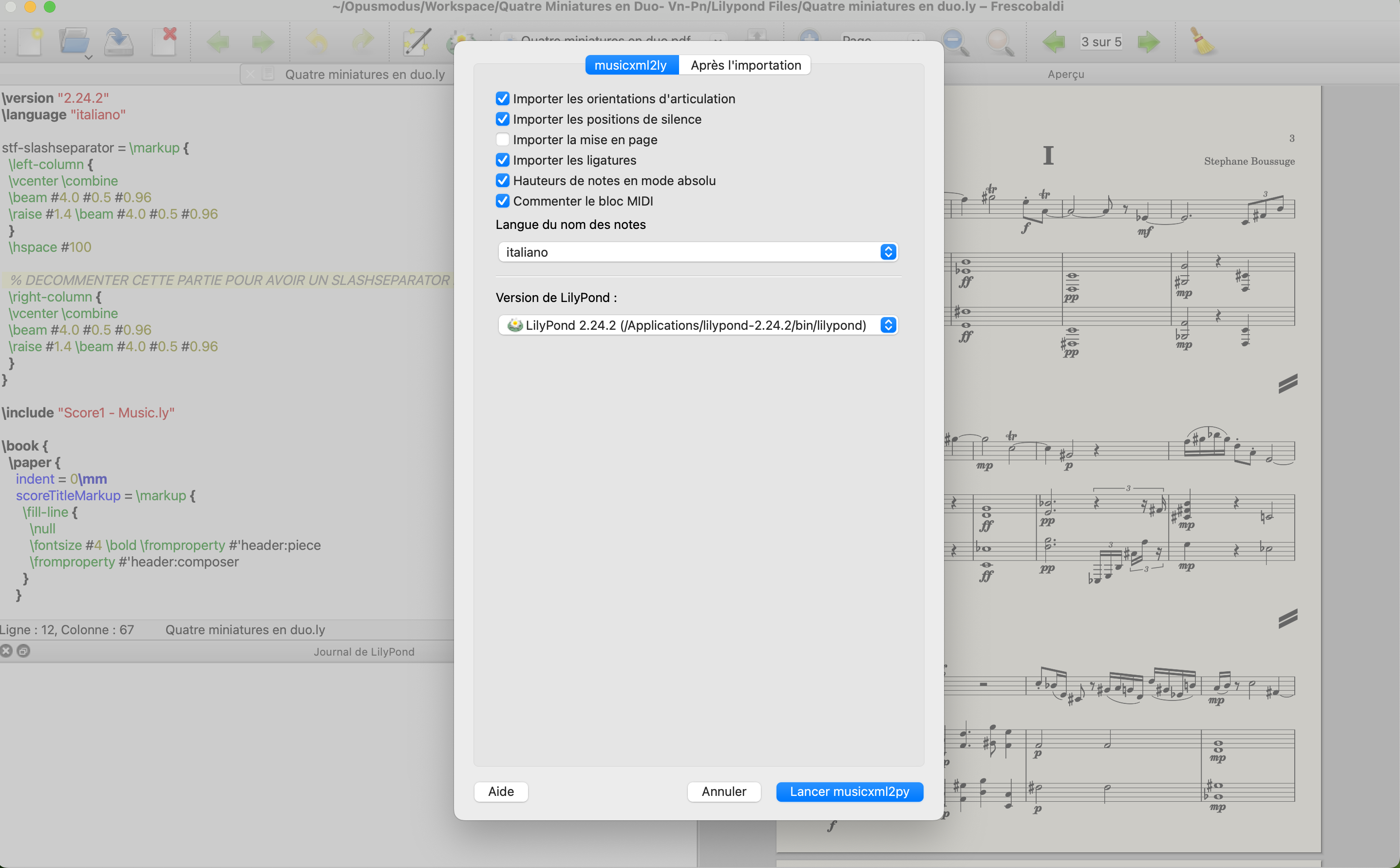-
Posts
1,056 -
Joined
-
Last visited
Content Type
Forums
Events
Store
Video Gallery
Everything posted by Stephane Boussuge
-
Several possibilities depend what kind of variations you want. The simplest one is random order applied only to lengths. (setf mat '((e d4 e4 fs4 gs4 q a4)(s b4 c5 b4 gs4 q a4 e fs4 e4))) (rnd-order mat :type :length) Another way I appreciate particularly is length divide: (length-divide '((3 4)(1 2)) mat :set 'max) but this last one add some intervals so it may be not what you're searching for... S.
-
Hi folks, Get this opportunity to improve you Opusmodus knowledge, until 2.4.24, you will get -30% on everything on Composer Workshop with the coupon code: easter24. Enjoy !
-

2 videos on orchestral sections
Stephane Boussuge replied to Stephane Boussuge's topic in Made In Opusmodus
The opmo file is a variant of one of the templates given with my video lesson pack: Designing generative orchestral templates with Opusmodus (level 2) - Composer Workshop WWW.COMPOSERWORKSHOP.COM Welcome to the course on "Designing Generative Orchestral Templates with Opusmodus"! In this course, we will explore the fascinating world of computer-assisted composition, specifically focusing on the powerful music composition environment known as Opusmodus. Opusmodus is a cutting-edge software tool that empowers composers, music theorists, and researchers to create... but I will share another one soon S. -
Here's two videos, a long one playing with live coding, generating some sections before assembly and another very short one showing evaluation and assembly for the construction of a short orchestral passage. S.
-

start-swank does not work in OM 3
Stephane Boussuge replied to HenryT's topic in Support & Troubleshooting
I still can't start swank on OM 3 unfortunately. -
Hi folks, a short electronic track in honor of Hubble telescope discovery... I've used the template shared here as starting point: Attached the Audio file, Opmo score and VCVRack. Best S. PillarsOfCreation.wav PillarsOfCreation.vcv PillarsOfCreation.opmo
-
Hi folks, Here's an example using a template for Opusmodus and vcvrack. Feel free to use it as a starting point for your own experimentations, VCVRack is free and driving it with OM is a great fun ! Attached to this post, the 2 files used in this short video example. That file will be probably available in the next OM update. Enjoy ! VCVRackTemplate1.opmo VCVRackTemplate1.vcv
-

Get-Time-Signature to Length-Span
Stephane Boussuge replied to JulioHerrlein's topic in Function Examples
Hi Julio, you can use get-span function: (setf ritmos (gen-repeat 4 (gen-length '((1 2 1 2 1 1) (1 1 1 1 1 2 1) (1 -3 1 -3 2 -2 4) (-3 1 -1 1 1 1)) '(16)))) (get-span ritmos) => (1/2 1/2 1 1/2 1/2 1/2 1 1/2 1/2 1/2 1 1/2 1/2 1/2 1 1/2) S. -

How to : Speaking piano with Opusmodus
Stephane Boussuge commented on Stephane Boussuge's video in How-To
I use the software Spear: https://www.klingbeil.com/spear/ -
musicxml-to-ly but if you use the great Lilypond Editor Frescobaldi, it is included in the menu and works very very well.
-
Lilypond works also very well with Opmo.
-
You may use :butlast
-

Working with Dictum, Dictum not evaluating
Stephane Boussuge replied to LeopoldMozart's topic in Support & Troubleshooting
Hi, the output of your loop get too many nested parenthesis. Use assemble-seq function to arrange this material as correct OMN expression usable by dictum. ;=====BIRDCALLS===== (setf bird1 '(3q d5 leg gs4 d5 leg gs4 d5 leg gs4)) (setf bird2 '(q a3 e. b3 x c5 leg e.. bb4)) (setf bird3 '(e fs4 leg c5 q bb4 3q fs4 stacc c5 bb4)) (setf rest1 '(-e)) (setf rest2 '(-q.)) (setf rest3 '(-e.)) ;=====OMN MAKER===== (setf loop1 (assemble-seq (gen-loop 7 (list (rnd-pick (list bird1 bird2 bird3)) (rnd-pick (list rest1 rest2 rest3)) (rnd-pick (list rest1 rest2 rest3)))))) (dictum '(:if e :do q) loop1) -
Hi, you can try this: ;=====BIRDCALLS===== (setf bird1 '(3q d5 leg gs4 d5 leg gs4 d5 leg gs4)) (setf bird2 '(q a3 e. b3 x c5 leg e.. bb4)) (setf bird3 '(e fs4 leg c5 q bb4 3q fs4 stacc c5 bb4)) (setf rest1 '(-q.)) (setf rest2 '(-h)) (setf rest3 '(-w)) ;=====OMN MAKER===== (apply-eval (rnd-sample 4 '(bird1 bird2 bird3 rest1 rest2 rest3)))
-
Hi, I've made a function long long time ago around this idea not following strictly Hindemith if I remember it correctly but it was based on the same idea/concept. Here's my function, you can probably tweak it to your needs. Please, if you improve it in anyway, share your improvement so it could be useful for me and community as well. Stephane ;;;=============================================================== ;;; sort chords by tension ;;;=============================================================== ;;Idée: classer des accords generés de maniere X par tension avec une courbe de tensions. ;;Analyser un accord ;;1. extraire un vecteur d'intervalles ;;2. Analyser le vecteur ;;3. retourner le resultat (defun ana-tens (ivect) "renvoie le taux de tension harmonique d'un vecteur d'intervalles. utilitaire pour h-tens" (let* ((v1 (*(nth 0 ivect) 6)) (v2 (*(nth 1 ivect) 4)) (v3 (*(nth 2 ivect) 3)) (v4 (*(nth 3 ivect) 2)) (v5 (*(nth 4 ivect) 1)) (v6 (*(nth 5 ivect) 5)) (r (+ v1 v2 v3 v4 v5 v6))) r)) (defun h-tens (chord) (do-verbose ("h-tens") "renvoie le taux de tension harmonique relatif d'un accord." (let* ( (r0 (if (equal chord '(nil)) '(c4) chord)) ; Si nil, remplace par une valeur simple (c4) (r1 (melodize r0)) ;extraction du vecteur d'intervalles (r2 (pitch-to-integer r1)) (r3 (find-unique (modus r2))) (r4 (if (> (length r3) 1) (pcs-prime-form r3 :vector) '(0 0 0 0 0 0))) (r5 (ana-tens r4)) ;analyse du vecteur d'intervalles ;il faut ensuite diviser le resultat obtenu par le nombre de pcs (cardinal-number) du set et on obtient le niveau relatif de tension harmonique. ; on s'assure d'abord de ne pas avoir un accord à 1 seul accord (r6 (float (/ r5 (length r1)) 1.0))) r6 ;retourne le resultat ))) ;;;creation d'une fonction qui prend en entrée une suite d'accords et qui renvoie cette suite triée ;;;par ordre de tension harmonique croissant ou decroissant. (defun extraitcar (lst) (loop for i in lst collect (car i))) (defun extraitcdr (lst) (loop for i in lst collect (cdr i))) (defun sort-chords-tens-up (chords) "ordonne une suite d'accords par ordre croissant de tension harmonique" (do-verbose ("sort-chords-tens-up") (let* ((tens (mapcar 'h-tens chords)) (a-list (pairlis chords tens)) (sorted (stable-sort a-list #'< :key #'cdr)) (chordprog (extraitcar sorted))) chordprog))) (defun sort-chords-tens-down (chords) "ordonne une suite d'accords par ordre decroissant de tension harmonique" (do-verbose ("sort-chords-tens-down") (let* ((tens (mapcar 'h-tens chords)) (a-list (pairlis chords tens)) (sorted (stable-sort a-list #'> :key #'cdr)) (chordprog (extraitcar sorted))) chordprog))) #| ;;;Usage ;;we generate some chords (setf chords (chordize (gen-loop 12 (rnd-unique 4 (integer-to-pitch (gen-integer 12)))))) ;;we sort chords by up tension (setf chords-up (flatten (sort-chords-tens-up chords))) ;;we sort chords by down tension (setf chords-down (flatten (sort-chords-tens-down chords))) |# ;;;====================================================================================
-

Infer scale from get-harmonic-path result
Stephane Boussuge replied to Cliff's topic in Suggestions & Ideas
Hi, you can have a look to the function: pcs-super-sets -
When you bind a variables with setf somewhere in lisp and evaluate it, it becomes available for the whole system until you close it and in any workspace.
-
In Common Lisp, `SETF` is a general-purpose assignment macro used to assign values to a designated place, such as a variable. It can be used for all forms of assignment, whether storing into an ordinary variable or a generalized variable. The syntax of `SETF` does not evaluate its first argument, which is the name of the variable. The second argument, which is the value to which the variable is set, is evaluated. The value returned by `SETF` is the value to which it set the variable. Comparatively, `DEFVAR` and `DEFPARAMETER` are used for defining variables, but with different implications and scopes. `DEFVAR` is used to establish a variable, but if the variable is already bound, redefining it with `DEFVAR` does nothing. `DEFPARAMETER`, on the other hand, always assigns a value to the variable, even if it is already bound. Both `DEFVAR` and `DEFPARAMETER` are typically used to define global variables, whereas `SETF` is used for assigning values to variables regardless of their scope. The scope of variables defined by `DEFVAR` and `DEFPARAMETER` is global, meaning the variables are accessible throughout the program. In contrast, `SETF` can be used within any scope, including local scopes within functions or global scopes, depending on where it is used. The key difference lies in their purposes: `DEFVAR` and `DEFPARAMETER` are for variable declaration (with `DEFPARAMETER` forcefully initializing the variable), while `SETF` is used for assigning or changing the value of a variable, irrespective of its scope.
-
The number of chord tones played is controlled with the :group parameter. About chord inversion or randomisation of position, it is probably possible to do a kind of post processing with rnd-order or something similar.
-
Very fun experience with OM spectral function! Have you ever heard a piano speaking?
-
Sorry, my mistake, I reply too quickly without thinking.... It is not chords inversion. It is the use of function length-divide internally who produce this result because length-divide apply some intervals. Look at the doc for length-divide function. If you provide intervals to the function you can modify this behavior, for example , if you want only the chords notes, you can do: (setf mat1 '((h a2b2e3f3gs3 mf) (h a2b2e3f3gs3 p) (q bb4c5gs5a5b5 mp q bb4c5gs5a5b5 p))) (chord-dictum '((:len h :chd 5 :div 5 :int '(0)) (:len q :chd 5 :div 4)) mat1 ) => ((5h a2b2e3f3gs3 mf a2b2e3f3gs3 a2b2e3f3gs3 a2b2e3f3gs3 a2b2e3f3gs3)
-
The chords are randomly inverted to add variety but keep the harmonic content. If you want to alter the pitch, you can use interval transposition in dictum.



